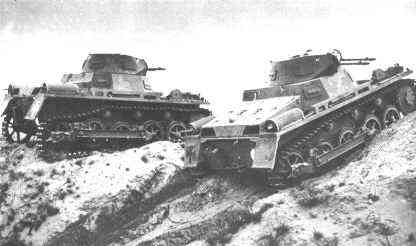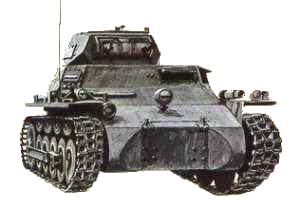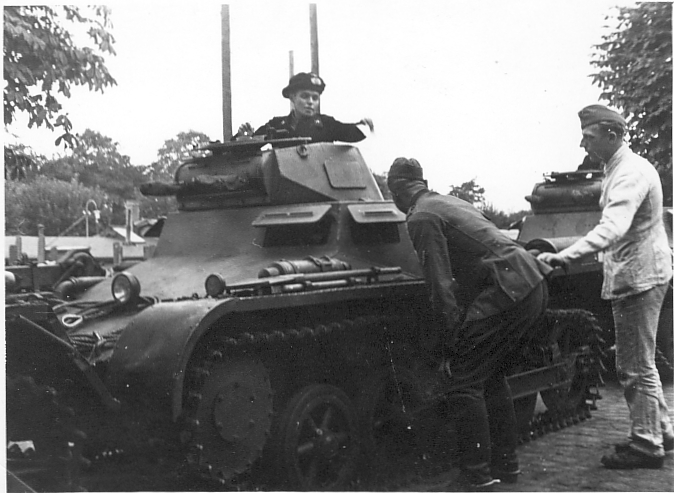

|
Panzerkampfwagen I
with the most common official designation as the Panzerkampfwagen I, or PzKpfw I. It also carried the official vehicle designation of Sonderkraftfahrzeug 101, or SdKfz 101. During the early period of its development, the name Landwirtschftlicher Schlepper, or L-S, meaning an industrial tractor as a cover name to deflect investigation into the then-illicit German development of tanks. The Panzer I was converted into a number of special-purpose vehicles and self-propelled guns. The Panzer I marked the first production tank design in Germany since the conclusion of World War I. In 1932, specifications for a light (5-ton) tank were made and issued to the German industrial manufacturers Rheinmetall, Krupp, Henschel, MAN and Daimler Benz. In 1933, the design by Krupp was chosen. It was based on the British Carden Loyd Mk IV Tankette, two of which had been secretly purchased from the Soviet Union. The Treaty of Versailles forbade Germany from producing any tanks so these versions were referred to as "Landwirtschaftlicher Schlepper" (agricultural tractors). The design was modified in late 1933 to combine the Krupp chassis with the Daimler Benz turret design touxiang. In 1934, the resulting tank was designated the Panzer I Ausf A (version A), and production began in July. The original Panzer I was designed as a light tank for reconnaissance and infantry support duties. However, the most important goal of its development was to provide a vehicle to begin forming and training a German tank force. It was to be replaced in the Panzer divisions as soon as possible by more capable purpose-designed combat tanks, although as it turned out, by the start of World War II, the Panzer I was still filling a significant role in these units due to extended time in getting more advanced tanks produced. The tank itself was produced in two primary variants. The original PzKpfw IA was underpowered and was replaced in production by the PzKpfw IB, with a more powerful engine and other improvements. The B model can be identified by the slightly longer hull and extra road wheel necessary for the larger engine. For the most part, the two versions were similar in operation. A few attempts were made to make a heavier armed tank or one able to participate in airborne operations, but few of these were made. By the time of the replacement of the Panzer I, it was long obsolete in any combat role, and thus many of the surviving chassis were converted to other roles. Most attempts to mount guns were less than successful due to the small size of the vehicle, but it was successful as a turret-less tractor, both for training of tank drivers and carrying cargo and munitions to front line units. 
Combat History The Panzer I first saw combat in 1936 in the Spanish Civil War as part of the German forces sent to assist General Franco and the Nationalists. The Panzer I turned out to be underpowered, under-gunned, and outclassed by the Soviet T-26 and BT-5 tanks used by the Republican forces. A number of Panzer Is were captured by the Republican forces, and fitted with 20 mm or 25mm anti-tank guns. The Panzer I was intended as a training tank, to be replaced by the Panzer III in actual combat. However, because of delays in the production of Panzer IIIs, the Panzer I was the main tank used in the invasion of Poland and was used extensively in the invasions of France, Denmark, and Norway. Fifteen Panzer IAs were purchased by Nationalist China, and saw combat in the Chinese Civil War. After Germany removed the Panzer I from combat they were used extensively for patrolling in the conquered territories and for the training of new Panzertruppen. Armor The Panzer I had 13 mm of unsloped or slightly sloped homogenous steel armor on all sides, with 8 mm of armor on the top of the turret, and 6 mm on the top and bottom of the hull. The armor was sufficient to stop rifle bullets and most machine-gun bullets, but could not stop anything heavier, such as anti-tank rifles and anti-tank guns. Even though the armor was relatively thin, the steel plates had been face-hardened, an expensive treatment which suggests that roles other than merely training had been considered. Armament Crew The Panzer I had a crew of two. The driver sat in the forward hull, while the commander sat in the turret and operated the guns. |

 continue article here:
continue article here:  The Panzer I was armed with a pair of 7.92 mm machine guns in the turret. These guns could be independently elevated, but otherwise fixed in the turret. This made the Panzer I a good tank against infantry and soft vehicles, but completely impotent against anything with armor. Mobility The Panzer IA had a 57 hp (43 kW) Krupp M305 4-cylinder gasoline engine, capable of propelling it at 37 km/h (23 mph) on good terrain, and a range of 145 km (90 miles) on-road. The IB had a 100 hp (75 kW), 6-cylinder Maybach NL38TR engine giving it a top speed of 40 km/h (25 mph), and a range of 170 km (105 miles) on-road.
The Panzer I was armed with a pair of 7.92 mm machine guns in the turret. These guns could be independently elevated, but otherwise fixed in the turret. This made the Panzer I a good tank against infantry and soft vehicles, but completely impotent against anything with armor. Mobility The Panzer IA had a 57 hp (43 kW) Krupp M305 4-cylinder gasoline engine, capable of propelling it at 37 km/h (23 mph) on good terrain, and a range of 145 km (90 miles) on-road. The IB had a 100 hp (75 kW), 6-cylinder Maybach NL38TR engine giving it a top speed of 40 km/h (25 mph), and a range of 170 km (105 miles) on-road.